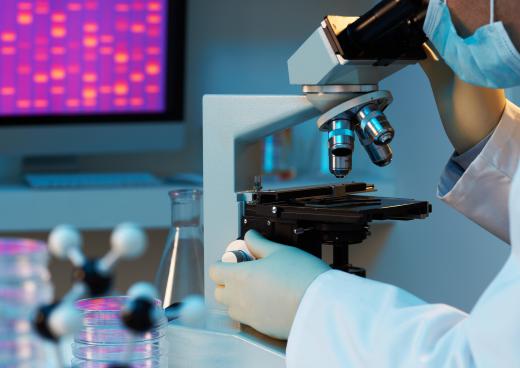What Is a Mechanical Stage?
 Mary McMahon
Mary McMahon
A mechanical stage is a microscope attachment that holds slides in place and allows the user to precisely control their position. These devices can be useful for manipulating slides at high magnifications and in delicate operations where position is very important. Attachments are available to convert a microscope's basic stage, a flat platform with clips, to a mechanical stage. Some new models come with mechanical stages or optional attachments. High powered microscopes in particular may need mechanical stages to work best.
To use a mechanical stage, the operator positions a slide on the stage and clips it in place. The eyepieces can be adjusted to provide the desired focus and magnification to allow the user to view the slide. Instead of manually repositioning the slide to look at a different area, the user controls the mechanical stage to pull the slide to a different region. Many work with adjustable knobs. Users may need to experiment at first because the orientation of the slide can be confusing when they’re looking through the eyepieces.

At very high magnifications, an operator may want to be able to make a micromovement to see a different part of a slide. Manual repositioning doesn’t offer the degree of precision available, while a mechanical stage does. The user can note the X and Y axis coordinates on the stage to carefully reposition the slide. The slide can be moved using the mechanical controls to scan it, allowing the user to search for something of particular interest and stop to examine it more closely.

In addition to moving slides back and forth and up and down, the mechanical stage may offer angle control. It is sometimes necessary to tilt slides or specimens. The technician can move the knobs to change the angle and examine a crystal structure or similar phenomenon from a different perspective. Such mechanical stages are more complex and can be harder to learn to operate, so they are usually only installed when they are necessary.
Computer controlled microscopes may allow a technician to control the mechanical stage with programmed comments or hands-free technology. Sequences can be entered in the computer, which performs the necessary adjustments, and it can also be controlled with verbal orders, in some cases. This can be useful for activities like demonstrations, where a scientist may want to focus on presenting information. The user can program the settings in ahead of time to move the slide while discussing different features as they come into view.
AS FEATURED ON:
AS FEATURED ON:












Discuss this Article
Post your comments